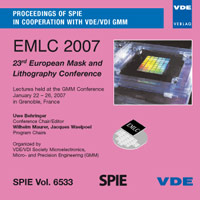Investigation on Immersion Defectivity Root Cause
Konferenz: EMLC 2007 - 23rd European Mask and Lithography Conference
22.01.2007 - 26.01.2007 in Grenoble, France
Tagungsband: EMLC 2007
Seiten: 8Sprache: EnglischTyp: PDF
Persönliche VDE-Mitglieder erhalten auf diesen Artikel 10% Rabatt
Autoren:
Farys, V.; Mestadi, K. (STMicroelectronics 850 rue Jean Monnet, F 38926 Crolles Cedex, France)
Gaugiran, S.; Feilleux, R.; Sourd, C. (CEA-Leti-Minatec, 17 Rue des Martyrs, 38054 Grenoble Cedex 9, France)
Cruau, D.; Warrick, S. (Freescale, 850 rue Jean Monnet, F 38926 Crolles Cedex, France)
Benndorf, M. (NXP semiconductors, 850 rue Jean Monnet, F 38926 Crolles Cedex, France)
Inhalt:
The introduction of immersion lithography in the production phase has been accompanied with high level of defects compared to standard process on dry lithography. Continuous process optimization allowed us to reduce the defectivity to dry lithography level. This learning cycle also permitted to improve our knowledge on immersion defectivity formation. Immersion lithography process cause specific defects type as watermarks, bubbles, extra pattern and swelling of lines. We will report in this article on our latest experiment on the understanding of defects formation during immersion process. The influence of the track and scanner parameters has been investigated as well as materials issue (resist, topcoat). Measurements of leaching, receding contact angle and water uptake have been performed in order to correlate with defect formation. It appears that material, track and scanner parameters play different role on the formation of specific immersion defects.


